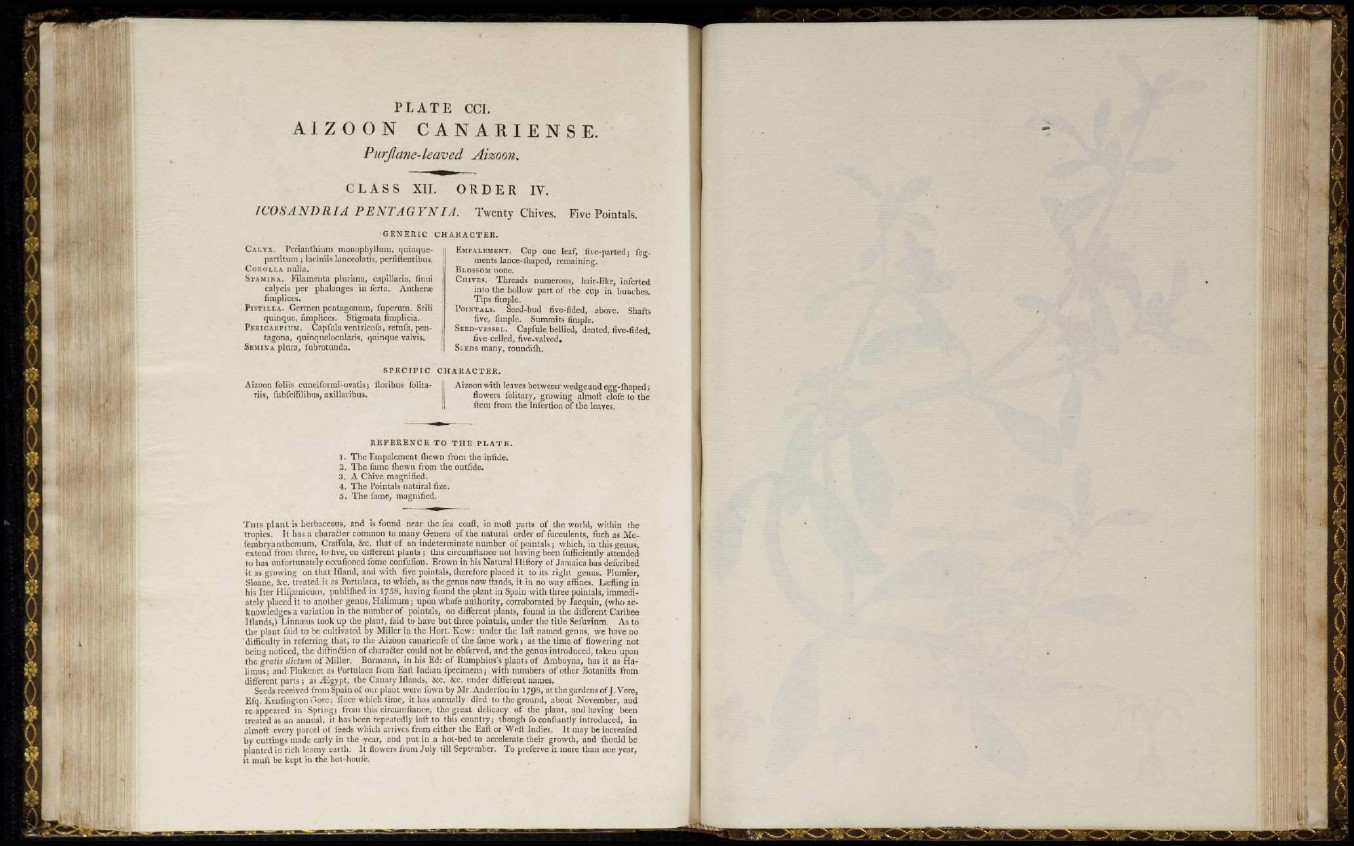
P L A T E CCI.
A I Z O O N C A N A R I E N S E.
Pm'flane-leaved Aizoon.
CLASS XII. ORDER IV.
fCOSANDRIA PENTAGYNIA. Twenty Chives. Five Pointals.
G E N E R I C C H A Ü A C T E E.
C A L Y X . Perianthíum monophyllum, quinquep
a r t i t um ; laciniis lanceolatis, periiíientibiis.
C O U O L L A nulla.
S T A U I N A . Filamenta pUirima, espillaría, iiuui
calycis per phalanges in feria. Antherae
fimplices.
P I S T I L L A . Germen pentagonum, fuperum. Stili
quinqué, fimplices. Stigraata fimplicia.
P E R I C A R P I U M . Capfula ventricofa, re tufa, pentágona,
qtiinquelocularis, quinqué valvis.
S E M I N A p l u i a , fubrotunda.
EMPALEMBNT. Cup one leaf, five-parted; feeuients
lance-ihaped, remaining.
BLOSSOM none.
C H I V E S . Threads numerous, hair-like, inferted
into t h e hollow part of the cup in bunches.
Tips fiinple.
P O I N T A L S . Seed-bud five-fided, above. Shafts
live, Ample. Summits (imple.
SEED-VESSEL. Capfule bellied, dented, !ive-fided,
five celled, five-valved.
SEEDS many, rouudifh.
S P E C I F I C C H A R A C T ER
Aizoon fotiis cunoiformi-ovatis; floribus folitariis,
fubfeililibus, axillaribus.
soon w i t h leaves between wedgcaiidegg-ihaped;
flowers folitary, growing almoit clofe to the
i t em from the hifertiou of the leaves.
R E F E R E N C E T O T H E P L A T E .
1. T h e Fan pa lenient ilicwn from the inlide.
2. The fame fhewn from the outride.
3. A Chive magnified.
4. T h e Pointals natural fize.
5. The lame, magnified.
T i n s p l a n t is herbaceous, and is found near the fea coaft, in mofl parts of the world, within the
tropics. It has a character common to many Genera of the natural order of fucculents, fuch as Mef'embryanthemum,
CralTula, &c. that of an i n d e t e r m i n a t e number of p o i n t a l s ; which, in this genus,
extend from three, to five, on different plants ; this circumflance not having been futficiently attended
IO has unfortunately occafioned fome confufion. Brown in his Natural Hifiory of Jamaica has defcribed
i t as growing on that Ifland, and with five pointals, therefore placed it to its right genus. Plumier,
Sloane, &c. treated it as Porlulaca, to which, as the genus now ftands, it in no way aflines. Lrefling in
his I t e r Milpauieum, pubfilhed in 1753, having found t h e plant in Spain with three pointals, immediately
placed it to another genus, H a l i m u m ; upon whofe authority, corroborated by Jacquin, (who acknowledges
a variation in the number of pointals, on different plants, fuund in the different Caribee
Itlands,) Linnteus took u p the plant, laid to have but three pointals, under the title Sefuvium. As to
t h e plant laid to be cultivated by Miller in the Hort. Kew: under the la ft named genus, we have no
difficulty in referring that, to t h e Aizoon canarienfe of the fame w o r k ; as the time of flowering not
being noticed, t h e diftinction of character could not be obferved, and t h e genus introduced, taken upon
t h e gratis dictum of Miller. Bunnann, in his Ed: of Rumphius's plants of Amboyna, has it as Halinnts;
and Plukenct as Portulaea from Eali Indian fpecimens; with numbers of other Botanifts from
different p a r t s ; as-'Egypt, the Canary lflands, &c. &c. under different names.
Seeds received from Spain of our plant were fown by Mr. Anderfon in I 7 0 s , at the gardens of J . Vere,
Efq. Kenfington Gore: (iuce which time, it has annually died to ihc ground, about November, and
re-appeared in Spring; from this circumflance, the great delicacy of the plant, and having been
t r e a t e d as an annual, it has been repeatedly loft t o this c o u n t r y ; though fo confiantly introduced, in
almoit every parcel of feeds which arrives from either the Eali or Welt Indies. It may be increafed
by cuttings made early in the year, and put in a hot-bed to accelerate their growth, and lhould be
planted in rich loamy earth. It flowers from J u l y till September. To prcferve it more than one year,
it mult be kept in the hot-houle.